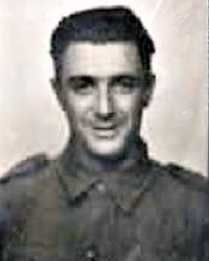
TALLENT, Keith Webb
| Service Number: | VX50004 |
|---|---|
| Enlisted: | 7 March 1941 |
| Last Rank: | Private |
| Last Unit: | General / Motor Transport Company/ies (WW2) |
| Born: | Timboon, Victoria, Australia, 24 September 1913 |
| Home Town: | Croydon, Maroondah, Victoria |
| Schooling: | Not yet discovered |
| Occupation: | motor Driver and Shop Assistant |
| Died: | Illness whilst a Prisoner of the Japanese , Thailand, 8 March 1944, aged 30 years |
| Cemetery: |
Kanchanaburi War Cemetery 1 E 31, |
| Memorials: | Australian War Memorial Roll of Honour, Ballarat Australian Ex-Prisoners of War Memorial, Croydon Civic Centre War Memorial, Croydon RSL Memorial Honour Roll, Croydon War Memorial |
World War 2 Service
| 7 Mar 1941: | Enlisted Private, VX50004, General / Motor Transport Company/ies (WW2) | |
|---|---|---|
| 7 Mar 1941: | Enlisted Australian Military Forces (WW2) , Private, VX50004, General / Motor Transport Company/ies (WW2) |
Keith Webb Talent's Early Life
Keith was born in Timboon, his father, before his death in a car accident, owned the White Star Mine, Curdies River. Born in Timboon to Ethel Maude Talent/Dalton, after his parent's death, he lived with his young siblings with grandparents, William Hardy Dalton and Lucy May along with his aunts and cousins in the crowded family home, during WW1. Following his mother's unfortunate second marriage and the loss of the mine, he moved to Croydon with his mother. His aunt, Sarah Blanch Magill/Dalton's returned letter from his uncle, Mathew Magill, KIA testifies to the crowded conditions, during and after the war at the Timboon home.
Ref. Returned Letter from Sarah Blanche Magill /Dalton to Mathew Magill K.I.A. France. (Original held by E.M.Magill, Ringwood, Victoria.)
Submitted 16 June 2024 by Ellen Magill
Research into Keith Webb Tallent
Born in Cobden on 24th September 1913, Keith Webb Tallent was the youngest child of Ethel Maude Tallent (nee Dalton) and Peter Webb Tallent. Keith’s father passed away when he was only 11 months old, leaving Ethel with three surviving children and several lawsuits for unpaid labor performed for the latte Petter Webb Tallent. The family lived on Mount View St, with the children most likely attending Croydon Central School. The walk to school would have taken Keith past the memorial which would one day bare his name for his service in WWII.
When Keith was 26 years of he attended the Royal Park enlistment facility at Camp Pell, enlisting only 6 months after Prime Minister Robert Gordon Menzies announced the beginning of Australia's involvement in the Second World War. While initially enlisted as a private, he was transferred to the Reserve Motor Transport Company two months later. His first overseas posting was to Singapore before travelling to Malaya (now Malaysia).
Drivers fulfilled a number of roles in WWII transporting supply items, including ammunition, between depots, as well as transporting people. Drivers often worked alone, driving through contested territory in tricky conditions, leaving them vulnerable to attack.
On the 10th April 1941, Keith was reported missing in action.
It was not until 2th October 1943, one and a half years after being first reported missing that Keith was located at a Thai Prisoner of War camp. Conditions in camp were grueling, with a lack of food and clean water, hard labor, and a host of tropical diseases leading to the deaths of 8,031 Australians in Prisoner of War camps during WWII. The prisoners of the camp were tasked with building the 415km Thai-Burma railway, alongside 13,000 other Australian POWs, 2800 of which died as a result of the labor and conditions. “All but 50 kilometres of the route was across rugged terrain covered in dense, malarial jungle. It would require building more than 600 bridges as well as hundreds of viaducts, embankments and cuttings.”
Disease was common in the camps, with cholera, dysentery, malaria, and skin diseases all common. Keith was declared deceased on the 8th March 1944, having died from dysentery. Dysentery and diarrhoea caused more than a third of prisoner-of-war deaths, most of which are preventable with sufficient hygiene, food and water, and medical attention. His final resting place is the Kanchanaburi War Cemetery.
“Somewhere back in the jungle came the notes of the Last Post. The babbling murmur of the camp stopped and all the men outside stood still … The acrid smell of the pyre drifted across the camp and, in the smoke, another man was gone.” Ray Parkin, former POW in Thailand, and worker on the Thai-Burma Railway.
On the 5th of September 1946, Ethel memorialised her son through publishing an article with journalist Vesta Junior entitled “Friends Across the Sea” in The Argus newspaper. The articles details the story of Keith and many other Australian soldiers making friends while “in Malaya during the tragically short period before the fall of Singapore.” Ethel shows the journalist a photo of Keith with a Chinese friend named Mr Ong, of Malacca. She had also received correspondence from Mr Ong that they were safe and were looking forward to hearing from their Australian friends. The article ends with the “hope that some day there will be some chance of mothers and other relatives of boys who were in Malaya meeting the loyal people who tried to be friendly to them there. There must be many a story to tell, not always a sad one, which might bring a little ease to those to whom the long years of our men's captivity in Japanese hands have brought such bitter thoughts.”
Submitted 26 September 2022 by Ella Birt










